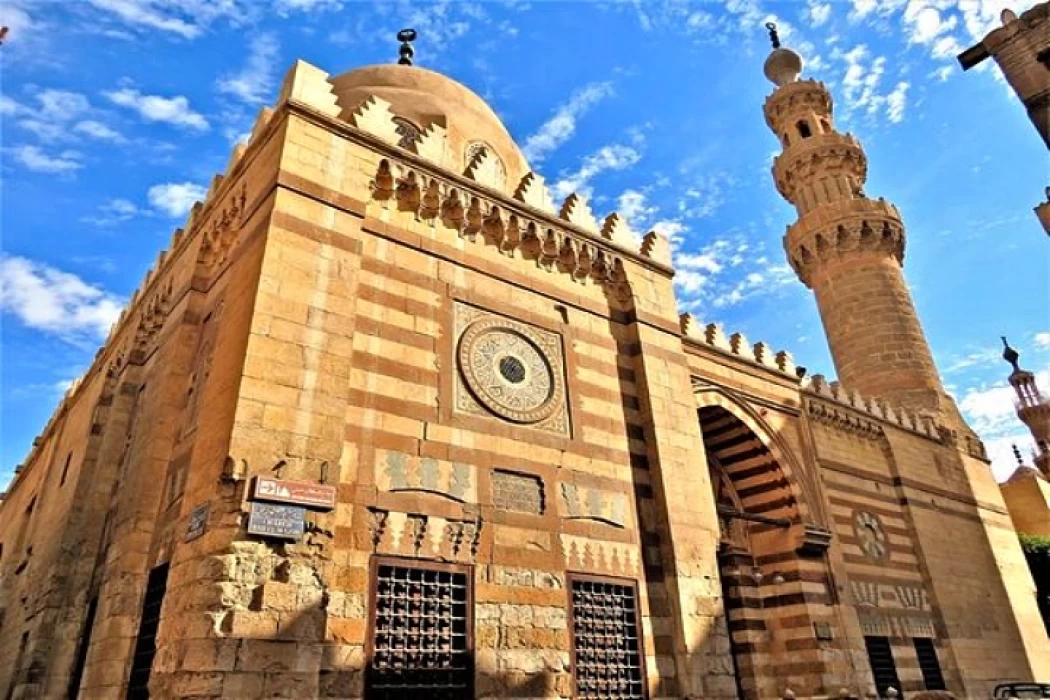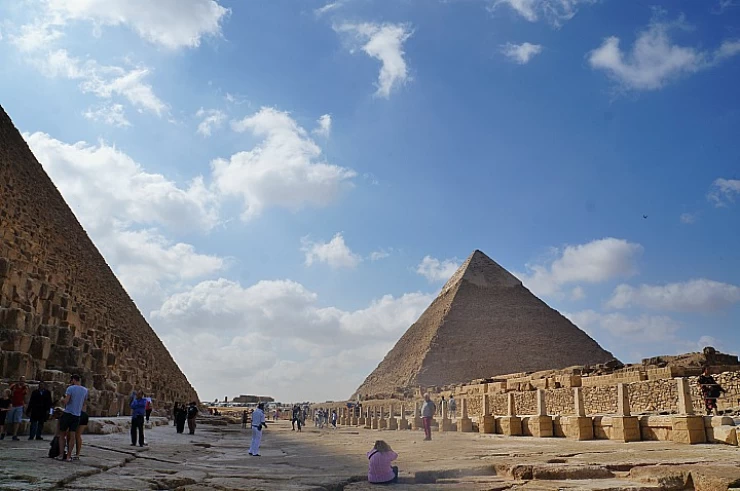
Aqsunqur Mosque | Amir Aqsunqur mosque
Jama'a Al -Aqsunqur (Blue Mosque)
The Aqsunqur Ibrahim Agha Mosque is Mustafzan or Ibrahim Agha Mosque, or what is known as "the Blue Mosque", one of the Islamic architectural masterpieces in Egypt. It was built by Prince Aq Sunqur al-Salari, one of the Mamelukes of Sultan Qalawun in the Al-Darb Al-Ahmar district, Bab Al-Wazir Street, Cairo Governorate, to be «a beacon Blue »lights up the area.
location
This mosque was originally established by the Mamluk prince Shams al-Din Aq Sunqur al-Farqani al-Silahdar in the year 676 AH / 1277 CE, but the current mosque was established by the Ottoman Prince Muhammad as two Mustaftan, and that was in 1080 AH / 1669 AD, and it is located behind the Court of Appeal in Darb Saada in Bab al-Khalq district in the central Cairo district. Its layout consists of a rectangular area, in the middle of which is an open courtyard surrounded by four iwans. The largest of them is the qibla iwan
history
The mosque was built in 1347 AD, in the Mamluk style over the tombs of the people of Cairo, even if digging began to lay the foundations, the builders found structures for the dead buried there, and the width of the mosque is about 80 meters and its length is 100 meters, and in its center, there is an open courtyard surrounded by four colonnades with columns, the largest of them The qibla gallery, which includes two aisles, and the remaining three aisles each.
The mosque has three doors: “one on the western façade, another in the northern façade, and the third on the eastern façade, and a shrine dome is attached to it.” The chest of the eastern portico is covered with beautiful blue tile tiles.

Aqsunqur Mosque | Amir Aqsunqur mosque
Amir Aqsunqur mosque
The main façade of the mosque is located on the western side of Bab al-Wazir Street, and in the middle of it is the main entrance that enters from the azimuth of the walls of the façade by about two meters.
It is surmounted by an arch carried on ribbons, and in the middle of the entrance is a door topped by a lintel containing green and white marble "docked" on the right of the door. Its doorstep is made of stalactites made of white and green marble as well. It is surrounded on the top by a large, concave "tray". On the left, there is another row of windows.
The mosque contains a marble pulpit and its sides are made of colored marble. Its railings, knots, and helmet are decorated with a variety of decorations, its door is crowned with a cornice from three stations of muqarnas, and it has two shutters of wood marquetry. This pulpit is considered the oldest of the few marble pulpits in the ancient mosques in Cairo.
The mosque includes a mihrab covered with marble and brick stones with floral motifs on the inner walls topped by an inscription that reads: “The Prophet, may God’s prayers and peace be upon him, preached in this blessed mihrab on the night of Saturday the ninth of Dhu al-Qa'dah in the year sixty-eight and eight hundred and he is standing and prays at this honorable mosque, Ibrahim Agha Mustaftan in 1062 AH ».. and attached to it is a mausoleum dome and the chest of the eastern portico covered with beautiful blue faience tiles.
The mosque was closed for nearly 21 years since 1992 after the earthquake that struck Egypt this year, and it was restored over four years at a cost of $ 2 million, to be reopened again in 2013.
You can learn fascinating facts about The Temples Of Ancient Egypt. Some people visited Egypt and learned everything about them.
Latest Articles
Admin
Seabourn Sojourn Cruise Stops in Safaga Port
The Seabourn Sojourn, the flagship vessel of Seabourn Cruise Line's ultra-luxury fleet, was built in 2008 at the T. Mariotti shipyard in Genoa, Italy. Measuring 198 metres, it can accommodate up to 450 guests in its 225 spacious all-suite staterooms.
Admin
Norwegian Sky Cruise Stops in Safaga Port
Norwegian Cruise Line operates a cruise ship called the Norwegian Sky. It was constructed in 1999 and can accommodate 2,004 passengers in addition to 878 crew members. The ship has several dining establishments, lounges and bars, a spa and fitness center, swimming pools, and a number of entertainment areas.
Admin
Explora II Cruise Stops in Safaga Port
Explora II, the second vessel in the Explora Journeys fleet, sets sail in 2024 to redefine luxury cruising. With 461 ocean-front suites, 9 culinary experiences, and 4 pools, this haven of sophistication and sustainability promises an unforgettable "Ocean State of Mind" journey to inspiring destinations.
Admin
Mein Schiff 6 Cruise Stops in Safaga Port
The Mein Schiff 6 is the latest cruise ship in the renowned TUI Cruises fleet, offering passengers a luxurious and sophisticated cruise experience. At 315 metres long, this floating resort features a range of dining options, entertainment, and recreational facilities, including a spa, fitness centre, and sports amenities.
Admin
Mein Schiff 4 Cruise Stops in Safaga Port
When the Mein Schiff 4 cruise ship docks in Safaga, Egypt, passengers are granted access to a realm of ancient wonders. Aboard this state-of-the-art vessel, guests can embark on meticulously curated shore excursions that showcase the region's most iconic landmarks, including the Giza Pyramids, the enigmatic Sphinx, and the remarkable tombs and temples of the Valley of the Kings in Luxor.
Admin
MS Europa Cruise Stops in Safaga Port
The Silver Moon, Silversea's latest flagship, is a luxury cruise ship that offers an exceptional travel experience for Venezuelans exploring Egypt. With a capacity of 596 guests and an impressive 40,700 gross tonnes, the Silver Moon maintains the small-ship intimacy and spacious all-suite accommodations that are the hallmarks of the Silversea brand.















